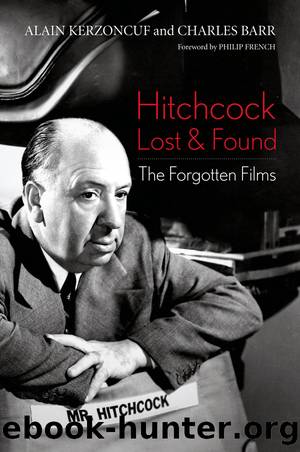Hitchcock Lost and Found by Alain Kerzoncuf

Author:Alain Kerzoncuf
Language: eng
Format: epub, mobi
Publisher: The University Press of Kentucky
Published: 2015-08-14T16:00:00+00:00
Figure 3.3. Advertisement for Rebecca (1940) and Men of the Lightship (David Macdonald, 1940) in the Entertainment columns of The Times, 29 July 1940.
As soon as Hitchcock’s involvement became known, the MoI had been attacked, predictably, by Michael Balcon, who had evidently offered without success to have the editing work done free of charge at his own base, Ealing Studios. He wrote on 20 November to the Head of Films Division, Jack Beddington, that “it is particularly galling to people over here to have work of this nature tampered with by people so far removed from actualities…. Anti-Hitchcock feeling is very strong.” But of course it made good sense for the re-editing to be done by someone who was much closer to the realities of the American market than Ealing was. Hitchcock was ideally positioned between the two countries and the two cultures, between American audiences and the aesthetics of British documentary production.
A memo from Bernstein to Bamford on 27 January 1941 suggests that he had by then made good progress: “Alfred Hitchcock phoned me from Hollywood on Friday night (2 a.m. actually) to say that Hutchinson of Twentieth Century Fox Films had agreed to release Hitchcock’s re-edited version of this film throughout the United States and Latin America, on a commercial basis.” It is clear, anyway, that by the start of April 1941 Men of Lightship “61” had entered U.S. distribution, giving it a chance to do its bit in encouraging pro-British sentiment—many months before the Pearl Harbor attack of 7 December tipped the United States into joining the war. Bernstein’s long memo of 3 April summarized the position thus: “The film has now been successfully cut and the voices re-dubbed, and Robert Sherwood has done the commentary…. Cdr Jarratt saw the film in America, and thinks it is excellent and that it will be a great success.”8
There is evidence of a screening in Connecticut as early as March 1941: a newspaper advertisement for Footsteps in the Dark (Lloyd Bacon), with Errol Flynn, includes the words, just below: “ADDED, MEN OF LIGHTSHIP ‘61.’ Filmed in England—Proceeds to Allied Relief.” There is similar evidence of screenings in Wisconsin in April and in Florida and Texas in May, and we can surely assume that these records represent just the tip of an iceberg of nationwide screenings.
Hitchcock’s work on the re-edit had thus achieved Bernstein’s objective, and we can now examine the changes he made.
The film “reconstructs” (the term used on the original credits) the shocking bomb attack by German planes on a lightship off the east coast of England, early in 1940. This is the basic narrative.
We are introduced to the crew of Lightship 61 and its skipper as they anticipate a period of shore leave; official arrangements are confirmed for a relief boat, Argos, to take over. From on board the lightship a floating mine is spotted, and a combined operation between crew members and a passing naval ship succeeds in blowing it up. Later, two planes approach, but it
Download
This site does not store any files on its server. We only index and link to content provided by other sites. Please contact the content providers to delete copyright contents if any and email us, we'll remove relevant links or contents immediately.
Call Me by Your Name by André Aciman(18965)
Ready Player One by Cline Ernest(12839)
How to Be a Bawse: A Guide to Conquering Life by Lilly Singh(6693)
Wiseguy by Nicholas Pileggi(4586)
The Kite Runner by Khaled Hosseini(4435)
On Writing A Memoir of the Craft by Stephen King(4214)
The Crown by Robert Lacey(4105)
Audition by Ryu Murakami(4099)
Call me by your name by Andre Aciman(4073)
Harry Potter and the Cursed Child: The Journey by Harry Potter Theatrical Productions(3965)
Gerald's Game by Stephen King(3918)
The Perils of Being Moderately Famous by Soha Ali Khan(3783)
Dialogue by Robert McKee(3582)
Dynamic Alignment Through Imagery by Eric Franklin(3489)
Apollo 8 by Jeffrey Kluger(3200)
How to be Champion: My Autobiography by Sarah Millican(3186)
Seriously... I'm Kidding by Ellen DeGeneres(3100)
Darker by E L James(3088)
History of Dance, 2E by Gayle Kassing(3000)
